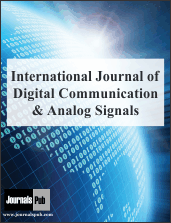Editor Overview
IJDCAS maintains an Editorial Board of practicing researchers from around the world, to ensure manuscripts are handled by editors who are experts in the field of study.
Publisher
JournalsPubAn Imprint of Dhruv Infosystems Pvt Ltd
A-118, 1st Floor, Sector-63, Noida, U.P. India,Pin-201301
E-mail: [email protected]
(Tel):
(Mob) (+91) 9810078958, +919667725932
Focus and Scope

About the Journal
International Journal of Digital Communication and Analog Signals primary aim of this journal is to bridge the gap of scientific communication between various research facilities working in this discipline, the journal largely covers every major aspect of digital communication and analog signaling, it also focus on the recent advances in the processing circuits. Journal publish high quality peer-review articles and editorial reviews, however other forms of communication like short communication and unsolicited comprehensive review articles are also welcome.
All contributions to the journal are rigorously refereed and are selected on the basis of quality and originality of the work. The journal publishes the most significant new research papers or any other original contribution in the form of reviews and reports on new concepts in all areas pertaining to its scope and research being done in the world, thus ensuring its scientific priority and significance.
Focus and Scope
[1] Frequency division multiplexing– Optical fiber sensors,Fiber lasers,Laser modes,Wavelength division multiplexing,m-channel wavelength division demultiplexer,Beat frequency demodulation,microstrip antenna arrays,MIMO radar,radar antennas,radar resolution,MIMO radar system,radar measurement,digital-beamforming method,transceiver chips
[2] Pulse code modulation- Modulation coding,Decoding,Pulse modulation,Bandwidth,Optical modulation,Optical pulses,Viterbi algorithm,Optical receivers,Performance gain,pulse-code modulation,signal detection,telecommunication channels
[3] Quantization- data compression,quantisation (signal),speech coding,trees (mathematics),vector quantisation, Codebook,Scalar Quantization,Signal to Quantization Noise Ratio,Speech Compression,Tree-Structured Vector Quantization,Deep learning,Quantization (signal),Stochastic processes,Object detection,Mobile handset,Classification algorithms,Image classification,
Vector Quantization
[4] Delta modulation- Transmitters,Delta-sigma modulation,Delta modulation,Pulse width modulation,Amplitude modulation,Linearity,Transfer functions,Quantization,Noise figure,Performance analysis,Frequency modulation,Delta-sigma modulation,Signal representations,Signal analysis,Signal processing,Clocks,Sampling methods,Physics,Fourier series,Bandwidth
[5] Voice and data integration- Databases,Servers,Software,Surgery,Schedules,Biomedical monitoring,Acoustics,Wireless LAN,Speech communication,Data communication,Packet reservation multiaccess,Delay effects,Communication system traffic,Media Access Protocol,Access protocols,Multiaccess communication,Personal communication networks,Base stations,Programmable control,Adaptive control,Access control,System performance,Performance analysis
[6] Baseband Transmission- baseband transmission channel,DVB video,signal processing,digital video broadcasting transmission model,digital filter,variable transmission parameters,linear distortions,additive noise,bit error rate,symbol error rate,picture quality evaluation analysis,cut-off frequency,Band-pass filters,Baseband,Codes,Software packages,Market research,Data communication,
[7] Analogue processing circuits- Analog circuits,Energy consumption,Voltage,CMOS process,CMOS technology,MOSFETs,Power generation,Digital systems,Costs,CMOS analog integrated circuits,CMOS analog integrated circuits,BiCMOS integrated circuits,Maximum likelihood decoding,Viterbi algorithm,Convolutional codes
[8] Digital signal processing- Digital signal processors,Multiprocessing,Parallel architectures,Real time systems,Signal processing,Adaptive signal processing,Digital communication,Cost function,Signal processing algorithms,Adaptive systems,Density functional theory,Signal processing,Robustness,Convergence,Digital signal processing
[9] Analog-to-digital converter- Analogue-digital conversion,ADC,analog-to-digital converter,code transition level,coherent sampling,DNL,ENOB,histogram,INL,LSB,missing codes,noise power ratio,Audio systems,Delta modulation,anti-aliasing filtering,
[10] Magnetic recording- Heat-assisted magnetic recording,Perpendicular magnetic anisotropy,Perpendicular magnetic recording,Signal to noise ratio,Hard disks,shingled heat-assisted, magnetic recording,interlaced magnetic recording,spinstand measurements,drive footprinting
Open Access Statement
IJDCAS is an open-access (OA) publication which provides immediate open access to its content on the principle that making research freely available to the public supports a greater global exchange of knowledge. All published works will be available to a worldwide audience, free, immediately upon publication. Publication in the journal is subject to payment of an article processing charge (APC). The APC serves to support the journal and ensures that articles are freely accessible online in perpetuity under a Creative Commons licenses.
Publication Ethics Statement
IJDCAS fully adhere to Code of Conduct of Publication Ethics (COPE) and to its Best Practice Guidelines. The Editorial Team enforces a rigorous peer-review process with strict ethical policies and standards to ensure the addition of high-quality scientific studies to the field of scholarly publication. In cases where ctit becomes aware of ethical issues, it is committed to investigating and taking necessary actions to maintain the integrity of the literature and ensure the safety of research participants. Click here to read more about the Research & Publication virtue ethics
Content Disclaimer
All IJDCAS the information’s, opinions, and views mentioned here represents the authors and the contributions of the articles. Publication of articles, advertisements, or product information does not constitute endorsement or approval by the journal. cannot be help responsible for any error or consequences while using the information updated in this journal. Although every effort is done by ctit to see that there’s no any inaccurate data, misleading data, opinion or statement within the journal, the data and opinions appearing in the articles are the responsibility of the contributors concerned.



